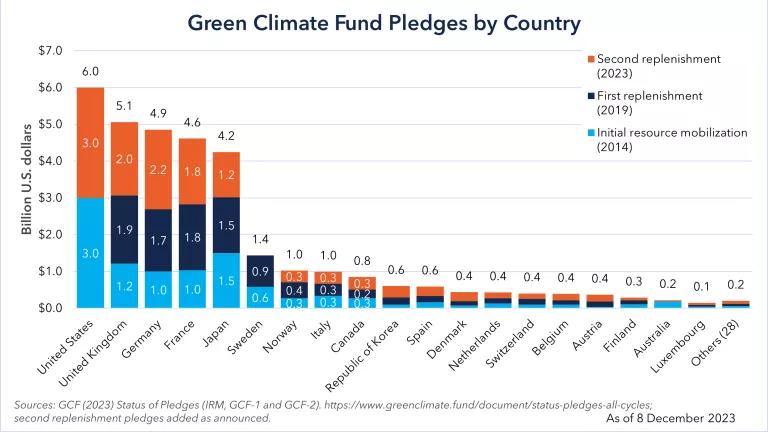
Finance is a critical component of limiting the increase of global temperature to no more than 1.5 degrees, avoiding ecosystem and biodiversity collapse, and ensuring an equitable future. Many of the strategies, including mitigation and adaptation, require funding. The relevant undertaking must be paid for at every stage—technology development, validation, implementation, and scaling.
Public funding has a crucial role in advancing and incentivizing climate change mitigation and adaptation measures. But the available public money will not be sufficient. Catalyzing multiple dollars of private funds for every dollar of public capital is critical to meet the climate challenge. Climate funding must also be delivered in ways that magnify impact, maximize efficiency, and ensure equitable access within and across countries.
International Commitments and Initiatives
COP26 brought a significant (though still insufficient) increase in public climate finance commitments from key countries. The private sector also has an increased awareness of the investment opportunities in climate action and the need to ramp up the flow of climate finance to developing and emerging economies. This is exemplified by the Glasgow Financial Alliance for Net Zero (GFANZ) member’s commitment to set science-based targets to reach net zero emissions by 2050 and work to mobilize private capital flows to the developing world. As Mark Carney notes in his Country Platforms Action Plan, the challenge now is getting this money into projects that meet climate needs and reduce inequality across the globe. Now that commitments have been made, concrete steps are needed to ensure that these targets are met.
To this end, NRDC has been working globally on various initiatives that help catalyze private capital to fight climate change. In the US, our work has revolved around reshaping financial regulations and using public financing mechanisms to mobilize private funding by establishing an international Green Bank Network.
Over the past ten years, the green bank model has proven effective at using limited public funds to mobilize far larger amounts of private capital. By de-risking projects, providing patient capital, creating new financial instruments, building local capacity and helping to demonstrate new technologies, green banks have been at the forefront of green finance innovation. Collectively, the members of the Green Bank Network have invested or committed US$50.4 billion in climate projects since the first green bank was founded in 2012, leveraging private investment in projects valued at US$134.7 billion. Today 27 green banks exist in 12 countries, and an additional 20 jurisdictions are exploring some form of green bank solution: whether a standalone institution, a separately managed green facility, or transforming a public development finance institution into a green finance leader.
China’s Key Role in Climate Finance
In recent years, China has made significant strides towards greening their financial system. In 2016, the government issued the Guidelines for Establishing the Green Financial System. These actions facilitated China in establishing a national green financial system. Through these policies and other subsequent reforms, the loan balance for green loans reached US$1.86 trillion at the end of 2020, with green bonds issuances exceeding US$100 billion.
In China, we have been working closely with partners to support the climate friendly transition of financial institutions and stakeholders. The ongoing interventions span dedicated research with top thinktanks, engagement with leading financial institutions, and efforts to mainstream climate finance to form a climate finance ecosystem.
In pursuit of enhancing the climate finance capacity in China, NRDC and the Climate Investment and Finance Association (CIFA) recently held the 2nd annual “International Conference on Climate-Friendly Banks”. CIFA is a leading industry association that consists of domestic and international research institutes, government agencies, financial institution and other key stakeholders.
Convening and Inspiring Key Stakeholders
The theme of the conference was “How Financial Institutions Can Transition to a Low Carbon Future.” It was attended by government officials such as Li Gao, director of the MEE’s Climate Change Response and Climate Investment and Financing Committee, representative from leading public and private banks, including some of the largest commercial banks in China (such as the Postal Savings Bank of China, China Construction Bank and China Merchants Bank), and the largest national development banks (China Development Bank and the Agricultural Development Bank of China).
Director Li Gao emphasized that financial institutions play a significant role in the implementation of China’s carbon neutrality goal though providing sufficient capital and strong investment/financing mechanisms.
NRDC also brought international climate finance experts to the conference, including experts from Amalgamated Bank, Aspiration, and NRDC’s very own Green Finance Center.
Sarah Dougherty, director of the NRDC Green Finance Center, discussed how public funds work alongside private capital to accelerate the growth of clean energy markets by reducing the risk for private funds and increasing demand for clean energy.
Ivan Frishberg, Chief Sustainability Officer of Amalgamated Bank, discussed their work on decarbonizing their operations, investments, and portfolios by adopting carbon accounting methodologies such as PCAF (Partnership for Carbon Accounting Financials). This strategy has allowed them to become the first US bank to publish science-based targets.
Additionally, Andrei Cherny, CEO of Aspiration, highlighted how Aspiration provides sustainability as a service, by utilizing financial tools to incentivize individuals, small/medium sized businesses, and large corporations to reduce their carbon footprints and integrate sustainability into their everyday actions.
Looking to the Future
CIFA believes many more banks are to join the climate-friendly bank initiative, and the expert committee will continue their climate-friendly banking research to help guide financial institutions achieve a "climate-friendly" strategic transformation.
Events like this create a platform for government regulators and financial institutions to share leading practices, inspire more innovations, and to discuss practical ways to implement their commitments to achieve net-zero goals. More importantly, it can encourage financial institutions to reach their commitments while also holding them accountable at the same time.


